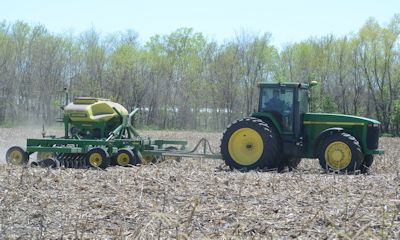May 28, 2016

With many parts of central and eastern Nebraska getting over five inches of rain in the last 30 days, soybean planting was behind the five-year average earlier this week. According to the USDA NASS Crop Report on May 23, soybean planting was 54% completed compared to the five-year average of 67% and last year's 54%. With the wet seven-day quantitative precipitation forecasts, many producers may be wondering if they need to rethink their agronomic practices – including relative maturity, row spacing, and seeding rate as they try and finish planting soybeans in June.
Here are a few considerations when planting soybean in June:

TOO EARLY TO CHANGE MATURITIES: Producers who still have soybeans to plant may be wondering if they need to switch to a shorter relative maturity. However, at this point, changing to shorter maturity groups isn't necessary, because late planted soybeans typically require fewer days to reach maturity than earlier planting dates.
Relative maturity
At this point, changing to shorter maturity groups isn't necessary, because late planted soybeans typically require fewer days to reach maturity than earlier planting dates.
Table 1 shows the soybean growth and development model based on results from a 2003-2004 planting date study conducted at Lincoln (average response of 14 varieties – 3.0 to 3.9 MG). Note the date that plants reached R8 or full maturity. In 2003, the mid-June planting date delayed maturity by 7 days compared to the early May planting date. In 2004, mid-June planting delayed maturity by 22 days even though the planting date was 50 days later. Because soybeans are photoperiod sensitive, flowering and development will be triggered by day length, resulting in similar maturity among planting dates, although earlier plantings will have more nodes and yield potential.
Table 1. UNL soybean growth and development results from 2003 and 2004.

~~~PAGE_BREAK_HERE~~~
If planting is delayed past June 15, it may be a good idea to go with the earliest maturity group number recommended for the area, such as reducing the MG number by 0.5 to 1.0. Frost before maturity becomes a concern with late June or July plantings, but don't try using a maturity group much shorter than that, or you sacrifice yield potential.
Row spacing
The next consideration is row spacing. With late planting, narrower row spacing is generally recommended. Because the longest day of the year occurs on June 21, and all days get shorter after that, soybeans need as much sunlight as possible to make pods, seed, and yield.
You want to see the canopy "green to the eye by the fourth of July" which may or may not be possible at this point. To close the canopy sooner, you may want to consider planting narrower than 30 inches. UNL research has shown that up to 5/8 bushels per acre can be lost for every day after May 1 that planting is delayed. So, it's important to mitigate the loss in the crop's ability to capture all incoming sunlight from now on.
While narrowing rows can help close the canopy quicker at this point, there are a few cautions to consider. In general, non-uniformity of seed depth placement and of seed-to-seed placement within the row is more of a concern with drills versus 15-inch or 30-inch planter units. Increasing seeding rates by 10% (potentially up to 20%) may be necessary to fill in gaps. This may not be as much of a concern with newer precision planting drills. Also, narrowing rows can favor diseases such as sclerotinia stem rot (white mold of soybean) that like a humid, moist canopy. In addition, if there is a history of white mold in the field, narrow rows are not recommended.
Seeding rate
Many sources recommend increasing seeding rates by 10% after early June for drilled and planted beans. However, there is some debate around this practice. An Iowa State University study published by DeBruin and Pederson in 2008 did not find a seeding rate (75K, 125K, 175K, 225K) by planting date (late April, early May, late May, and early June) interaction for yield, indicating no need for increased seeding rates at later planting dates.
Growers will need to evaluate this recommendation based on their normal seeding rates and planting equipment. Nebraska farmers through the Nebraska On-Farm Research Network have evaluated soybean seeding rates from 2006-2013, many under May planting conditions.
For additional information on late-planting soybeans, contact Nathan Mueller, University of Nebraska cropping systems educator in Dodge and Washington counties at [email protected], Aaron Nygren, Extension water and crops educator in Colfax County at [email protected], Jenny Rees, Extension educator in Clay County at [email protected], or Jim Specht, UNL emeritus professor of agronomy at [email protected].
Source: UNL CropWatch
You May Also Like




